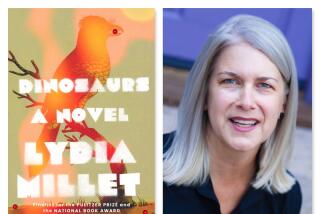John Ostrom, 77; Paleontologist Pursued Dinosaurs’ Link to Birds
- Share via
John Ostrom, the Yale paleontologist who almost single-handedly convinced the scientific community that birds are descended from dinosaurs and whose discoveries provided the underpinning for the “Jurassic Park” books and movies, died Saturday at the Sarah Pierce Assisted Living Community in Litchfield, Conn., university officials said Wednesday.
Ostrom, 77, had suffered from Alzheimer’s disease for several years and died of pneumonia.
Before Ostrom’s work, dinosaurs were widely considered to be slow-footed, indolent, cold-blooded and dim-witted reptiles that disappeared from Earth some 65 million years ago, leaving behind only a few fossilized bones to mark their passage.
“Dinosaur biology had strayed into a backwater in the 1920s and 1930s,” said paleontologist Robert Bakker of the Morrison Natural History Museum in Morrison, Colo. Researchers who considered entering the field “were often told that dinosaurs were slow and stupid, and that people who studied them were slow and stupid.”
But the field underwent a major renaissance in the 1960s, triggered in large part by Ostrom’s findings.
A key paper in 1963 on duck-billed dinosaurs, a type of hadrosaur, “challenged the whole paradigm,” Bakker said. Ostrom argued that the herbivorous creatures were not slow and soggy beasts that lived in swamps like hippos, but upright and speedy land creatures “like bipedal buffaloes.”
That view was reinforced with his 1964 discovery in Montana of a small, two-legged creature called Deinonychus. Ostrom painted a picture of an aggressive, warm-blooded carnivore with a high metabolic rate that hunted in packs and brought down larger prey with superior numbers. Its most prominent feature was a large curved blade of a claw -- hence the name, Deinonychus, or “terrible claw” -- that it used for slashing open its prey.
With its long, powerful tail, Deinonychus could walk around in an upright position, leaving its two stubby front legs free for fighting and other manipulations.
Ostrom found four of the creatures positioned around the much larger skeleton of a plant-eating dinosaur called Tenontosaurus. He concluded that the four smaller dinos had been killed by the larger one before the rest of the pack ultimately brought it down.
Deinonychus was the prototype for the vicious velociraptors in “Jurassic Park” and the behavior of the creatures is based on Ostrom’s behavioral findings. Author Michael Crichton wrote in the first book’s introduction that reading about Ostrom’s discovery got him wondering what it would be like to bring back to life intelligent, fast-moving, kick-boxing dinosaurs.
Ostrom cataloged more than two dozen similarities between Deinonychus and birds. After examining the fossilized skeleton of the earliest known bird, the Haarlem archaeopteryx, he began arguing forcefully that the two species were closely related and that Deinonychus, or a dinosaur very like it, was a predecessor to modern-day birds, particularly flightless birds like the ostrich.
That idea had actually been proposed by the 19th century naturalist Thomas Henry Huxley, but had been discarded in favor of the view that dinosaurs were reptiles.
Ostrom’s views were not greeted warmly. “They said, ‘Oh John, you’re crazy,’ ” he recalled in 1999. The idea that dinosaurs “were more firm of soul and quick of step was quite heretical,” Bakker said.
Over a 30-year period, however, other research supported his conclusion and the idea that birds were descended from dinosaurs became widely accepted. The crowning evidence in its favor was the 1996 discovery in China of the fossils of feathered dinosaurs.
“I never expected to see anything like this in my lifetime,” Ostrom said at the time. “I literally got weak in the knees when I first saw photos. The apparent covering on this dinosaur is unlike anything we have seen anywhere in the world before.”
Today, Bakker added, “The evidence is overwhelming that birds are dinosaurs.”
John Harold Ostrom was born in New York City in 1928 and raised in Schenectady, N.Y., where he did his undergraduate work at Union College. He had planned to become a physician like his father, but was diverted after reading George Gaylord Simpson’s book “The Meaning of Evolution.”
“I was so fascinated that I wrote to the author, who was very famous and at the height of his career,” Ostrom recalled in a 1997 interview. “A week later, I received a reply from him and soon I knew I wanted to be a paleontologist.” Simpson invited him to visit Columbia University, where he subsequently enrolled.
He studied with Edward H. Colbert, the leading dinosaur specialist of the day. Colbert began the process of popularizing the dinosaur, but viewed them as “sad, slow, stupid creatures that deserved to be extinct,” Bakker said. After Ostrom’s graduation, Bakker added, he “definitely broke with his mentor.”
Colbert’s wife, Margaret, had impressed on the young Ostrom the importance of illustration, and his subsequent papers were copiously illustrated with finely drawn images of fossils.
Ostrom taught for a year at Brooklyn College and then spent five years at Beloit College in Wisconsin before he joined Yale in 1961. He spent the rest of his career there until health problems forced his retirement in 1992.
Ostrom was preceded in death in 2003 by his wife of 51 years, the former Nancy Grace Hartman.
He is survived by two daughters, Karen Ostrom of Goshen, Conn., and Alicia Linstead of Larkspur, Calif., and three grandchildren.






